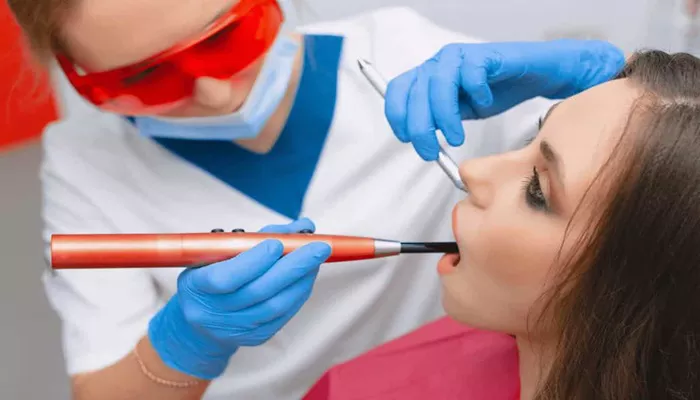cosmetic dentistry types
Cosmetic dentistry encompasses a wide range of treatments, each targeting specific aspects of a person’s teeth and smile. The main types of cosmetic dentistry procedures are as follows:
1.Teeth Whitening: Teeth whitening is one of the most common cosmetic dental treatments. It involves bleaching teeth to remove stains and discoloration caused by age, food, beverages, or smoking. Whitening can be done in-office by a dentist or at home with prescribed kits.
2.Dental Veneers: Veneers are thin shells made from porcelain or composite resin that cover the front surface of teeth. They are custom-made to improve the color, shape, size, or alignment of teeth, and they are especially useful for addressing issues like chipped, cracked, or stained teeth.
3.Dental Bonding: Bonding involves applying a tooth-colored resin to the tooth’s surface to correct imperfections such as chips, cracks, or gaps. It can also be used to reshape teeth or cover up stains. The procedure is generally fast, non-invasive, and requires minimal tooth reduction.
4.Dental Crowns: Crowns are custom caps placed over a damaged tooth to restore its strength, shape, and appearance. Crowns are often used when a tooth is severely damaged or weakened by decay, and they can be made from materials such as porcelain, metal, or a combination of both.
5.Dental Implants: Implants are a permanent solution for replacing missing teeth. A titanium post is surgically placed into the jawbone, and a crown is placed on top of the post to resemble a natural tooth. Implants are considered highly durable and provide a long-lasting solution for tooth loss.
6.Invisalign and Clear Aligners: For those looking to straighten their teeth without traditional metal braces, Invisalign and clear aligners are a popular option. These clear, custom-made aligners gradually shift teeth into proper alignment and are virtually invisible, offering a more discreet alternative to braces.
7.Gum Contouring: Gum contouring (also known as gum reshaping) is a procedure designed to improve the appearance of the gums. It involves removing excess gum tissue or reshaping the gum line to create a more balanced and attractive smile.
8.Smile Makeover: A smile makeover is a comprehensive treatment plan that may include multiple cosmetic dental procedures. The aim is to enhance the overall aesthetics of the smile by addressing issues with teeth, gums, and bite alignment.
cosmetic dentistry procedures
The specific procedures chosen for cosmetic dentistry depend on the patient’s needs, preferences, and the goals of treatment. Below are some of the most popular procedures:
1.Teeth Whitening
In-office whitening: A stronger bleaching gel is applied by the dentist, and the process can take 30 minutes to an hour. The results are immediate.
Take-home kits: These are provided by the dentist and typically take 1–2 weeks for optimal results. They contain a weaker bleaching gel compared to in-office treatments.
2.Veneers
The dentist prepares the teeth by removing a small layer of enamel, ensuring the veneers fit properly. Impressions are taken to create custom veneers, which are then bonded to the teeth.
3.Dental Bonding
A tooth-colored resin is applied to the tooth, shaped to correct imperfections, and hardened with a special light. The process usually takes 30–60 minutes per tooth.
4.Crowns
A crown requires two visits. The first involves taking impressions and preparing the tooth, while the second involves placing the custom-made crown on the prepared tooth.
5.Dental Implants
The procedure involves surgically placing a titanium post into the jawbone. After the bone heals, a crown is attached to the post. The process may take several months, as it involves healing time.
6.Invisalign
Clear aligners are worn for 20–22 hours a day and are changed every 1–2 weeks. Regular visits to the dentist are necessary to monitor progress.
7.Gum Contouring
This procedure involves the removal of excess gum tissue using a laser or scalpel. It is typically done under local anesthesia and may require a few days of recovery.
cosmetic dentistry cost
The cost of cosmetic dentistry varies depending on the procedure, the complexity of the treatment, and the location of the dental practice. Below is a general breakdown of costs for common cosmetic dental procedures:
1.Teeth Whitening
In-office treatments typically cost between $400 and $1,000.
At-home whitening kits from a dentist range from $200 to $400.
2.ental Veneers
Porcelain veneers typically cost between $800 and $2,500 per tooth.
Composite resin veneers are generally more affordable, ranging from $250 to $1,500 per tooth.
3.Dental Bonding:
Bonding usually costs between $100 and $600 per tooth.
4.Dental Crowns
Crowns generally range from $800 to $3,000 per tooth, depending on the material used (porcelain crowns are usually more expensive).
5.Dental Implants
Implants can cost between $1,500 and $6,000 per implant, depending on the complexity and materials used.
6.Invisalign
Invisalign treatments range from $3,000 to $8,000 for a complete treatment plan.
7.Gum Contouring
Gum reshaping can cost between $1,000 and $3,000, depending on the extent of the procedure.
It’s important to note that these costs may vary based on geographic location, the dentist’s experience, and the materials used. Many dental offices offer payment plans or financing options to help manage the costs of cosmetic procedures.
cosmetic dentistry grants
While cosmetic dentistry can be expensive, there are potential grants and financial assistance options that may help reduce the cost of treatment:
1.Dental Schools: Many dental schools offer discounted rates for cosmetic dental procedures performed by students under the supervision of licensed professionals. These treatments are typically more affordable than those offered by private practices.
2.Healthcare Credit Cards: Some patients choose to finance their cosmetic dental procedures through healthcare credit cards, which often offer interest-free periods for the first several months.
3.Dental Discount Plans: These are membership-based programs that offer discounts on various dental procedures, including cosmetic treatments. These plans may help make cosmetic dentistry more affordable.
4.Personal Loans: Some individuals take out personal loans or use home equity lines of credit to cover the cost of cosmetic dental work.
5.Grants for Low-Income Individuals: While cosmetic dentistry is generally not covered by traditional insurance, there are a few nonprofit organizations and government programs that offer grants or funding for low-income individuals needing dental care. However, these grants are usually limited to restorative procedures rather than purely cosmetic ones.
6.Payment Plans: Many dental practices offer in-house financing or installment plans, allowing patients to pay for their treatment over time.
FAQs about Cosmetic Dentistry
1.Will people know I’ve had cosmetic treatments?
No! Cosmetic dentistry has improved a great deal over the years and the materials used can be perfectly matched to the surrounding teeth. Crowns, veneers, and bonding resins can’t be identified as anything other than natural, especially since the gloss on the surfaces is identical to natural teeth.
2.What is the difference between a crown and a veneer?
A veneer is more a cosmetic choice and covers the front of the tooth only while a crown covers an entire damaged or missing tooth. Porcelain veneers can be used to cover broken, cracked, or chipped teeth. They are especially useful on the front teeth. Veneers last longer, between 10 and 20 years in general, and are usually less expensive than crowns.
Crowns are usually more expensive than veneers but are often covered by dental insurance to some degree.
3.How does that differ from an implant?
Dental implants are a permanent solution to missing or badly damaged teeth. The materials used are very durable and are biocompatible with the human body. The titanium posts that hold one or more crowns are surgically inserted into the jaw where the missing teeth were previously.
The entire process, including insertion of the titanium posts, grafting if necessary, healing, and addition of the replacement teeth can take from 3 months to a year, depending on the patient/situation. The implants are permanent, though. They provide the same stability and reliability as natural, healthy teeth. However, this method of tooth replacement is more expensive compared to other dental options and not always covered by dental insurance.
There has arguably been no greater advancement in modern dentistry in 40 years than dental implants.


